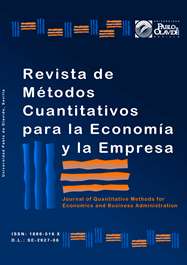La escala de Likert de 5 ítems y la correspondencia de la escala de porcentaje con implicaciones para el uso de modelos con variables lingüísticas (difusas)
DOI:
https://doi.org/10.46661/revmetodoscuanteconempresa.4010Palabras clave:
toma de decisiones, evaluación, variables lingüísticas difusas, estudio internacional, escala LikertResumen
El objetivo de este trabajo es examinar cómo las personas perciben la correspondencia entre la escala Likert de 5 ítems y la escala de porcentaje (la correspondencia LS-PS en adelante). ¿Los cinco elementos de la escala Likert son equidistantes? ¿La gente usa la misma escala al evaluar diferentes objetos? ¿Se diferencian hombres y mujeres? ¿Son diferentes las personas de diferentes países / culturas? El método del estudio fue un cuestionario con 661 encuestados participantes de la República Checa, Ecuador y Francia. Los resultados indican que la escala Likert de 5 ítems no es ni equidistante ni simétrica. Además, existen diferencias (altamente) estadísticamente significativas en la correspondencia LS-PS con respecto a la ubicación, edad o género de los encuestados. Los resultados se pueden utilizar como entrada para un modelo de toma de decisiones más preciso asociado con variables lingüísticas (difusas).
Descargas
Citas
Allen, E., & Seaman, C. (2007). Likert Scales and Data Analyses. Quality Progress, 40(7), 64-65.
Blaikie, N. (2003). Analyzing Quantitative Data. From Description to Explanation. Sage Publications, Thousand Oaks, 353. DOI: 10.4135/9781849208604.
Carrasco, R.A., Villar, P., Hornos, M.J., & Herrera-Viedma, E. (2012). A Linguistic Multi-Criteria Decision Making Model Applied to the Integration of Education Questionnaires. International Journal of Computational Intelligence Systems, 4(5), 946-959.
Casola, V., Preziosi, R., Rak, M., & Troiano, L.A. (2005). Reference Model for Security Level Evaluation: Policy and Fuzzy Techniques. Journal of Universal Computer Science, 11(1), 150-174. DOI: 10.3217/jucs-011-01-0150.
Clason, D.L., & Dormody, T.J. (1994). Analyzing data measured by individual likert-type items. Journal of Agricultural Education, 35(4), 31-35. DOI:10.5032/jae.1994.04031.
Creswell, J.W. (2008). Educational Research: Planning, Conducting and Evaluating Quantitative and Qualitative Research. New Jersey, United States: Pearson Education Inc.
Dawes, J. (2008). Do Data Characteristics Change According to the number of scale points used? An experiment using 5-point, 7-point and 10-point scales. International Journal of Market Research, 50(1), 61-77.
Edwards, A.L., & Kenney, K.C. (1946). A comparison of the Thurstone and Likert techniques of attitude scale construction. Journal of Applied Psychology, 30(1), 72-83. DOI: 10.1037/h0062418.
Hasson, D., & Arnetz, B.B. (2005). Validation and Findings Comparing VAS vs. Likert Scales for Psychosocial Measurements. International Electronic Journal of Health Education, 8, 178-192.
Hesketh, B., Prior, R., Gleitzman, M., & Hesketh, T. (1988). Practical Applications and Psychometric Evaluation of a Computerised Fuzzy Graphic Rating Scale. Advances in Psychology, 56, 425-454.
Holeček, P., & Talašová, J. (2010). FUZZME: A new software for multiple-criteria fuzzy evaluation. Acta Universitatis Matthiae Belii ser. Mathematics, 16, 35-51.
Joshi, A., Kale, S., Chandel, S., & Pal, D.K. (2015). Likert Scale: Explored and Explained. British Journal of Applied Science & Technology, 7(4), 396-403.
Likert, R. (1932). A Technique for the Measurement of Attitudes. Archives of Psychology, 140, 1-55.
Lima Jr., F.R, Carvalho, G.M.R., & Carpinetti, L.C.R. (2016). A methodology based on fuzzy inference and SCOR® model for supplier performance evaluation. Gest. Prod., São Carlos, 2016 23(3), 515-534. Available from http://www.scielo.br /scielo.php?script=sci_arttext&pid=S0104-530X2016000300515&lng=en&nrm=iso. Accessed on 11 Nov. 2018. DOI: 10.1590/0104-530x2625-15.
Lin, L., & Yeh, H. (2012). Linking Consumer Perception of Store Image Using FANP. iBusiness, 4(1), 18-28. DOI: 10.4236/ib.2012.41003.
Norman, G. (2010). Likert scales, levels of measurement and the “laws” of statistics. Advances in Health Science Education, 15(5), 625-632.
Prasad, B. (2016). Using Likert Type Data in Social Science Research. Confusion, Issues and Challenges. International Journal of Contemporary Applied Sciences, 3(2), 36-49.
Traylor, M. (1983). Ordinal and interval scaling. Journal of the Market Research Society, 25(4), 297-303.
Yan, H., Zeng, X., Bruniaux, P., Chen, Y., & Zhang, X. (2017). Development of a new knowledge-based fabric recommendation system by integrating the collaborative design process and multi-criteria decision support. Textil Research Journal, 88(23), 2682-2698. DOI: 10.1177/0040517517729383.
Willits, F.K., Theodori, G.L. & Luloff, A.E. (2016). Another Look at Likert Scales. Journal of Rural Social Sciences, 31(3), 126-139.
Publicado
Cómo citar
Número
Sección
Licencia

Esta obra está bajo una licencia internacional Creative Commons Atribución-CompartirIgual 4.0.
El envío de un manuscrito a la Revista supone que el trabajo no ha sido publicado anteriormente (excepto en la forma de un abstract o como parte de una tesis), que no está bajo consideración para su publicación en ninguna otra revista o editorial y que, en caso de aceptación, los autores están conforme con la transferencia automática del copyright a la Revista para su publicación y difusión. Los autores retendrán los derechos de autor para usar y compartir su artículo con un uso personal, institucional o con fines docentes; igualmente retiene los derechos de patente, de marca registrada (en caso de que sean aplicables) o derechos morales de autor (incluyendo los datos de investigación).
Los artículos publicados en la Revista están sujetos a la licencia Creative Commons CC-BY-SA de tipo Reconocimiento-CompartirIgual. Se permite el uso comercial de la obra, reconociendo su autoría, y de las posibles obras derivadas, la distribución de las cuales se debe hacer con una licencia igual a la que regula la obra original.
Hasta el volumen 21 se ha estado empleando la versión de licencia CC-BY-SA 3.0 ES y se ha comenzado a usar la versión CC-BY-SA 4.0 desde el volumen 22.










